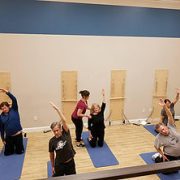Three Red Flags Your Hamstring Strain is Probably Something Else
A hamstring strain is a common injury I see in active patients aged 40 and above. But sadly – it’s also one of the most common mis-diagnoses I see as well.
First, what does a true hamstring strain or injury look like?
A true hamstring strain typically presents with a sudden, sharp pain in the back of your thigh. Usually during activities such as sprinting, jumping, or sudden changes in direction. The injury often occurs due to overstretching or overloading the muscles beyond their capacity. Thus, leading to microscopic tears within the muscle fibers. Symptoms typically include tenderness, swelling, and bruising in the affected area, along with difficulty walking or bending the knee. To recover from a hamstring strain, you first need to heal the injured muscle/tissue. Then properly strengthen it so it can handle all the activities you want to do. This involves some combination of rest and therapeutic movement at first, followed by carefully prescribed strengthening and loading of the damaged tissue so that it heals back strong and resilient. When a hamstring injury is accurately diagnosed, and properly rehabbed, you can return to all the activities you love and it shouldn’t bother you again.
If you’ve recently suffered an injury to your hamstring – and it doesn’t sound like what I’ve just described – then you’ll want to keep reading – because there’s a good chance it was mis-diagnosed and your treatment is all wrong.
Here are 3 red flags that indicate your hamstring strain is probably something else – and usually a back problem instead:
1. You have chronic hamstring pain
A true hamstring strain is simply an injury to your soft tissue (muscle) and it should heal with time. Now, sometimes you don’t rehab it properly, and it can result in chronic problems, but it shouldn’t be chronic pain. There’s a difference – let me explain. A poorly rehabbed hamstring is likely to cause problems elsewhere in your body (namely your hip and knee), but the hamstring itself won’t remain chronically painful. You might trigger a poorly rehabbed hamstring when you do activities that bother it, but at rest, it will be for the most part “healed”. If you experience chronic achiness, especially at rest or when you’ve been sitting for a long time, this is likely something else. Signs like this often point to an undiagnosed back problem. This is especially true if when you first hurt your hamstring it seemed to have come out of nowhere – for example – you just woke up with it one day or it came on gradually. True hamstring injuries are painful where you hurt it, and go away with time and certainly with proper rehab. A chronic pain in your hamstring that lingers for months or years, especially when you’re at rest, is probably something else.
2. Numbness and Tingling in your butt or leg
This symptom is almost always a red flag that the problem is stemming for your lower back or sacrum (tail bone area of your spine). This is because the nerves responsible for sensation in both your butt and leg originate from your spine. Your hamstring, on the other hand, is a muscle. Anatomically speaking – it can’t directly refer numbness to anywhere in your leg. With a true hamstring strain, you’ll experience localized pain, tenderness, and even swelling – but not numbness. So if you’ve suddenly started experiencing pain in the area of your hamstring, and are also having numbness and tingling in your leg, then your hamstring strain is probably due to something else – most likely a problem in your spine.
3. You feel pain below your knee
Your hamstring is the big group of muscles in the back of your thigh (you have three of them). They are responsible for flexing your knee and extending your hip. They originate from a bone at the bottom of your pelvis, deep inside your butt, and attach into various areas behind your knee. Because of where your hamstring is located, it’s impossible to feel true hamstring pain below your knee. This is a big red flag to me that the problem is likely coming from your spine. Now, it’s possible that your lower leg has begun to compensate for a poorly rehabbed hamstring strain and it’s hurting due to that. However, if you feel pain radiating from the back of your thigh, past your knee, and into your lower leg – it’s likely a back problem. Fun fact: 38% of all lower leg pain comes from a source within your spine even if you don’t have any back pain at all. So it’s very possible that pain in the back of your thigh and lower leg could be originating from your lower back.
Keep an eye out for these three red flags next time you feel pain or strain in your hamstring.
Remember that in most cases, you’ll know when you’ve strained your hamstring. With a true hamstring strain, the pain occurs at the time of injury and it’s fairly obvious. But if your hamstring pain comes out of nowhere, becomes chronic, starts feeling numb and tingly, or you’re experiencing pain below your knee – then you must consider that it could be something else – and that it’s likely a back problem. Talk to a physical therapy specialist who understands how to diagnose this properly. If you don’t get the root cause right, you won’t get the treatment right, and it will only delay the time it takes to get back to doing all the activities you love.
Are you local to Portsmouth, NH?
Consider speaking to one of my specialists by booking a free discovery visit HERE. They’ll ask you what’s been going on and see if we would be a good fit to help you 🙂
Dr. Carrie Jose, Physical Therapist and Pilates expert, owns CJ Physical Therapy & Pilates in Portsmouth and writes for Seacoast Media Group. To get in touch, email her at [email protected].










